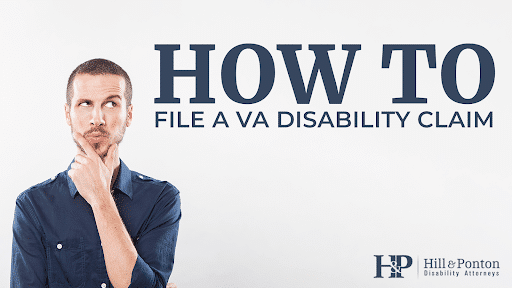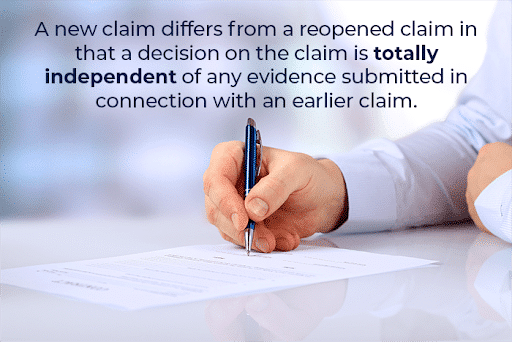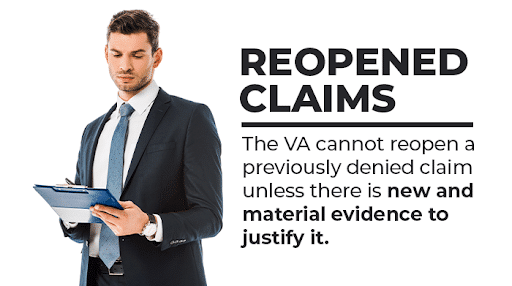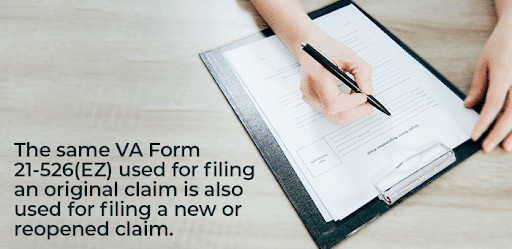Back to Basics – How to File New & Reopened VA Disability Claims
Our Back to Basics series breaks down how to file a VA disability claim. In the first PART TWO: Back to Basics post we discussed the necessary documents the United States Department of Veterans Affairs requires for a veteran to file an original claim for VA disability benefits. Once the VA has made a decision on a veteran’s original claim, and the decision has become final, the veteran may later file additional claims. As promised, we will now discuss in detail on how to file new and reopened claims.
What Are New Claims?
When filing a new claim for VA disability compensation, there are three primary types of claims that may be considered new claims.
A new claim is a claim for a benefit that may or may not have been filed before. Generally, the decision made on the claim is based entirely on new evidence. These may include claims for:
- increased disability evaluation
- special monthly compensation
- individual unemployability
A new claim differs from a reopened claim in that a decision on the claim is totally independent of any evidence submitted in connection with an earlier claim. For example – A veteran was granted service connection for a knee condition in 1965. In 1970, the veteran began experiencing symptoms of post-traumatic stress disorder. A buddy eventually persuaded the veteran to file a claim for service connection for his nervous disorder. Because his claim was filed after the decision on his original claim became final and because he had never before filed a claim for service connection for post-traumatic stress disorder, his claim is considered new.
What Are Reopened Claims?
A reopened claim is a claim filed by a disabled veteran for a benefit that was previously denied (and the decision to deny has become final). VA cannot reopen a previously denied claim unless there is new and material evidence to justify it. Here is a basic definition of what this means:
- New evidence is evidence that the VA has never before considered in connection with specific benefits claimed.
- Material evidence is evidence that is relevant to and has a direct bearing on the issue at hand.
So, additional evidence of the veteran’s medical condition can be enough for the VA to reopen the claim. For example, a veteran was treated several times during service for pain in his elbow. He filed a claim for service connection in 1989, but his claim was denied because no orthopedic abnormalities were found on VA examination. Two years later, the veteran’s private health care provider x-rayed the elbow and noted arthritic changes in the joint. The veteran submitted the medical records as new evidence to VA. Because it suggested residual of his in-service elbow problems did exist, VA reopened his claim for the current disability.
As we learned in my last post, an original claim must be filed using VA Form 21-526(EZ). The VA doesn’t require a specific application process or form to file a new or reopened claim. Oftentimes, veterans use VA Form 21-4138, Statement in Support of Claim, but this is not required; they may also simply submit a signed request on a blank piece of paper. The most important thing, however, is knowing what to include in that piece of paper. Veterans can find these forms on VA.gov.
If a veteran is trying to establish service connection for a disability, his or her statement should include name of the specific disability (ies) for which the veteran wishes their claim to be considered. This is true for a disability not previously claimed, a disability that was previously denied, or if the veteran is claiming that their service-connected disability has worsened.
Additionally, the statement should include all dates and places of treatment for the disability. If the disability has not been previously claimed, this may include dates and places of all in-service treatment and places of treatment since discharge. If the disability has been previously denied, the veteran should include information about new and material evidence that is being submitted with the claim. Remember, for VA to reopen a previously denied claim, evidence must be submitted which warrants the reopening of the claim. And, of course, always remember to sign and date the statement. Make your name and Social Security Number, or C-file number, are legible and clear on the piece of paper.
In addition to the statement, the veteran may include supporting documentation such as medical evidence that supports the specified disability. If treated at a non-VA facility, the veteran must complete VA Form 21- 4142. VA can get these records for the veteran if a VA form 21-4142 is signed for each doctor or treatment facility.
Thus far in our series, we have learned basic information pertaining to the process of filing an original claim, new and reopened claims.
In our next post we will discuss where to send the claim application, and we will try to simplify the claims process.
Have Questions About Your VA Claim?
If your VA claim was denied or you received a lower disability rating than you think you deserve, the team at Hill & Ponton are available to help. Our veterans disability attorneys are committed to helping former military service members and their family members seek veterans benefits. We can help you navigate the U.S. Department of Veterans Affairs claims and appeals process, representing you as you seek compensation.








